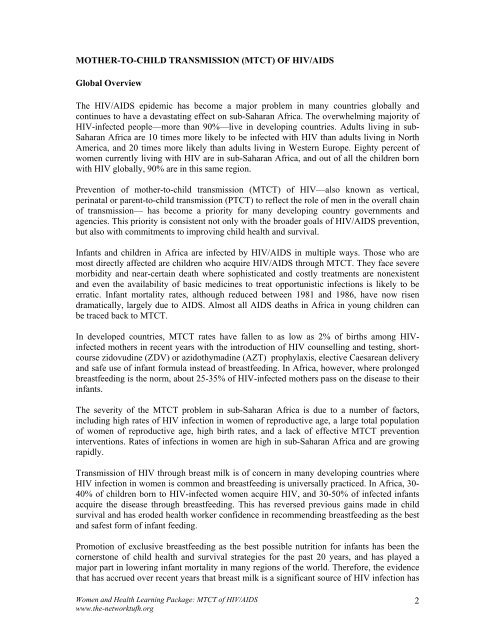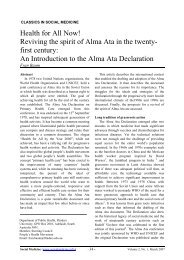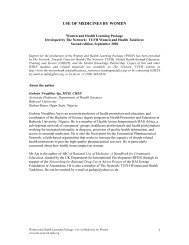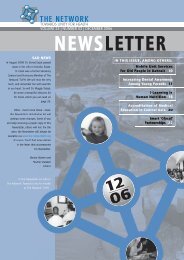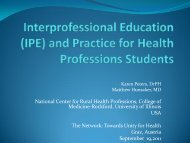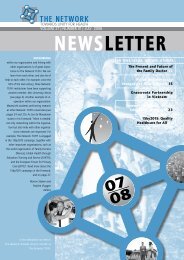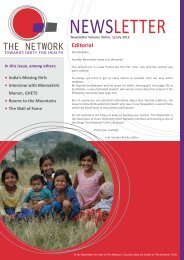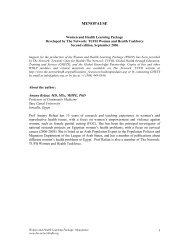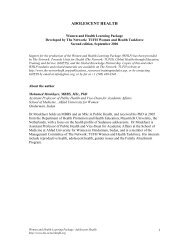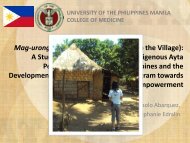WHLP MTCT HIV_AIDS.pdf - The network - Towards Unity For Health
WHLP MTCT HIV_AIDS.pdf - The network - Towards Unity For Health
WHLP MTCT HIV_AIDS.pdf - The network - Towards Unity For Health
You also want an ePaper? Increase the reach of your titles
YUMPU automatically turns print PDFs into web optimized ePapers that Google loves.
MOTHER-TO-CHILD TRANSMISSION (<strong>MTCT</strong>) OF <strong>HIV</strong>/<strong>AIDS</strong>Global Overview<strong>The</strong> <strong>HIV</strong>/<strong>AIDS</strong> epidemic has become a major problem in many countries globally andcontinues to have a devastating effect on sub-Saharan Africa. <strong>The</strong> overwhelming majority of<strong>HIV</strong>-infected people—more than 90%—live in developing countries. Adults living in sub-Saharan Africa are 10 times more likely to be infected with <strong>HIV</strong> than adults living in NorthAmerica, and 20 times more likely than adults living in Western Europe. Eighty percent ofwomen currently living with <strong>HIV</strong> are in sub-Saharan Africa, and out of all the children bornwith <strong>HIV</strong> globally, 90% are in this same region.Prevention of mother-to-child transmission (<strong>MTCT</strong>) of <strong>HIV</strong>—also known as vertical,perinatal or parent-to-child transmission (PTCT) to reflect the role of men in the overall chainof transmission— has become a priority for many developing country governments andagencies. This priority is consistent not only with the broader goals of <strong>HIV</strong>/<strong>AIDS</strong> prevention,but also with commitments to improving child health and survival.Infants and children in Africa are infected by <strong>HIV</strong>/<strong>AIDS</strong> in multiple ways. Those who aremost directly affected are children who acquire <strong>HIV</strong>/<strong>AIDS</strong> through <strong>MTCT</strong>. <strong>The</strong>y face severemorbidity and near-certain death where sophisticated and costly treatments are nonexistentand even the availability of basic medicines to treat opportunistic infections is likely to beerratic. Infant mortality rates, although reduced between 1981 and 1986, have now risendramatically, largely due to <strong>AIDS</strong>. Almost all <strong>AIDS</strong> deaths in Africa in young children canbe traced back to <strong>MTCT</strong>.In developed countries, <strong>MTCT</strong> rates have fallen to as low as 2% of births among <strong>HIV</strong>infectedmothers in recent years with the introduction of <strong>HIV</strong> counselling and testing, shortcoursezidovudine (ZDV) or azidothymadine (AZT) prophylaxis, elective Caesarean deliveryand safe use of infant formula instead of breastfeeding. In Africa, however, where prolongedbreastfeeding is the norm, about 25-35% of <strong>HIV</strong>-infected mothers pass on the disease to theirinfants.<strong>The</strong> severity of the <strong>MTCT</strong> problem in sub-Saharan Africa is due to a number of factors,including high rates of <strong>HIV</strong> infection in women of reproductive age, a large total populationof women of reproductive age, high birth rates, and a lack of effective <strong>MTCT</strong> preventioninterventions. Rates of infections in women are high in sub-Saharan Africa and are growingrapidly.Transmission of <strong>HIV</strong> through breast milk is of concern in many developing countries where<strong>HIV</strong> infection in women is common and breastfeeding is universally practiced. In Africa, 30-40% of children born to <strong>HIV</strong>-infected women acquire <strong>HIV</strong>, and 30-50% of infected infantsacquire the disease through breastfeeding. This has reversed previous gains made in childsurvival and has eroded health worker confidence in recommending breastfeeding as the bestand safest form of infant feeding.Promotion of exclusive breastfeeding as the best possible nutrition for infants has been thecornerstone of child health and survival strategies for the past 20 years, and has played amajor part in lowering infant mortality in many regions of the world. <strong>The</strong>refore, the evidencethat has accrued over recent years that breast milk is a significant source of <strong>HIV</strong> infection hasWomen and <strong>Health</strong> Learning Package: <strong>MTCT</strong> of <strong>HIV</strong>/<strong>AIDS</strong>www.the-<strong>network</strong>tufh.org2


